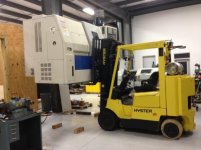with temporary added counterweight ? All three rated 15,500 lbs with standard counterweight. For example I once lifted a Maho MH800C machining center which weighed 13,600 lbs with a CAT GC70K.... which sounds within the 15.5K capacity except being a VMC I was picking it up way beyond the 24" load center rating....probably the equivalent of lifting 20,000 lbs at 24" really.
What I need to unload/load now is a VMC that weighs 15,300 lbs and just wonder if one of those three lifts might do it with extra counterweight ? Hard to say since I don't really know how far off 24" load center I will be. Thoughts ?
https://www.practicalmachinist.com/maho30.jpg
Another example... VMC at below link weighed only 11,700 lbs... but picking up at the front, the load center was way way beyond 24"...
https://www.practicalmachinist.com/yang2.jpg
https://www.practicalmachinist.com/yang3.jpg
What I need to unload/load now is a VMC that weighs 15,300 lbs and just wonder if one of those three lifts might do it with extra counterweight ? Hard to say since I don't really know how far off 24" load center I will be. Thoughts ?
https://www.practicalmachinist.com/maho30.jpg
Another example... VMC at below link weighed only 11,700 lbs... but picking up at the front, the load center was way way beyond 24"...
https://www.practicalmachinist.com/yang2.jpg
https://www.practicalmachinist.com/yang3.jpg







